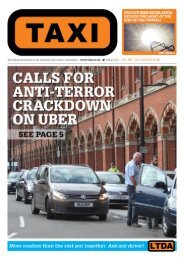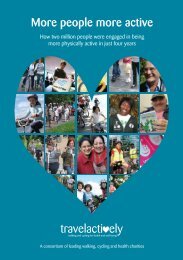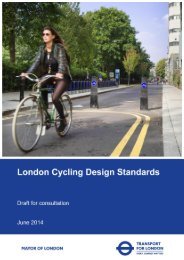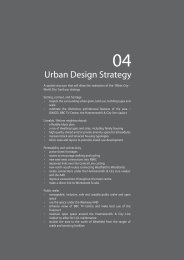Travel in London Travel in London
travel-in-london-report-8
travel-in-london-report-8
You also want an ePaper? Increase the reach of your titles
YUMPU automatically turns print PDFs into web optimized ePapers that Google loves.
10. The <strong>London</strong> 2012 Games and their legacy – an update<br />
Boroughs, <strong>in</strong> the context of a whole-<strong>London</strong> sample of about 8,000 households.<br />
<strong>Travel</strong> <strong>in</strong> <strong>London</strong> report 6 also set out group<strong>in</strong>gs of ‘comparator’ boroughs that<br />
could be used to identify differential change <strong>in</strong> the six Growth Boroughs, reflect<strong>in</strong>g<br />
progress towards Games legacy goals. When compar<strong>in</strong>g results from this survey<br />
over time, it is important to recognise that the relatively small sample each year<br />
limits the level of disaggregation at which it is possible to identify change. Also the<br />
wider backdrop of demographic change <strong>in</strong> the Growth Boroughs will have an effect<br />
on the consistency of these <strong>in</strong>dicators over time.<br />
Overall person trip rates and household car availability<br />
Average person trip rates are a basic measure of travel, and are normalised so as to<br />
take account of differ<strong>in</strong>g absolute levels of population <strong>in</strong> each borough. Car<br />
ownership rates are a similarly basic measure of access to this form of transport,<br />
changes to which should be viewed <strong>in</strong> the context of transport mode share<br />
aspirations for <strong>London</strong> and the Growth Boroughs specifically. These are of<br />
particular <strong>in</strong>terest given the observed trend towards lower levels of car ownership<br />
and use observed across <strong>London</strong> over recent years, and the historic connection<br />
between car ownership levels and general prosperity. Table 10.5 summarises key<br />
data for both <strong>in</strong>dicators.<br />
Table 10.5<br />
Person trip rates (all modes) and household car ownership rates for<br />
Olympic Growth Boroughs (residents of boroughs only). Seven-day week,<br />
multi-year average values.<br />
Borough/area<br />
Resident average<br />
trip rate (3 year<br />
pre-Games)<br />
2009/10-<br />
2011/12<br />
Resident<br />
average trip<br />
rate (2 year<br />
post-Games)<br />
2013/14-<br />
2014/15<br />
Resident<br />
households<br />
with access to<br />
one or more<br />
cars (3 year<br />
pre-Games)<br />
2009/10-<br />
2011/12<br />
Resident average<br />
households with<br />
access to one or<br />
more cars (2 year<br />
post-Games)<br />
2013/14-<br />
2014/15<br />
Bark<strong>in</strong>g & Dagenham 2.1 2.1 55% 61%<br />
Greenwich 2.1 2.6 64% 60%<br />
Hackney 1.9 2.1 36% 34%<br />
Newham 2.4 2.3 45% 44%<br />
Tower Hamlets 2.4 2.3 37% 28%<br />
Waltham Forest 2.0 2.5 60% 58%<br />
Growth total/average 2.2 2.3 49% 46%<br />
‘Geographic’ comparison 2.6 2.6 57% 58%<br />
‘Most similar’ comparison 2.4 2.5 51% 52%<br />
Non-legacy boroughs 2.5 2.5 60% 58%<br />
Inner <strong>London</strong> 2.5 2.5 43% 40%<br />
Outer <strong>London</strong> 2.4 2.4 69% 68%<br />
Greater <strong>London</strong> 2.5 2.5 58% 57%<br />
Source: TfL Plann<strong>in</strong>g, Strategic Analysis.<br />
It is seen from table 10.5 that overall person trip-rates tend to be lower than<br />
average <strong>in</strong> the Growth Boroughs, compared to the various <strong>London</strong> comparators, as<br />
<strong>in</strong> general do car ownership rates – a feature that has not changed significantly with<br />
the latest data. There is also little evidence of differential change between the<br />
193 <strong>Travel</strong> <strong>in</strong> <strong>London</strong>, Report 8








